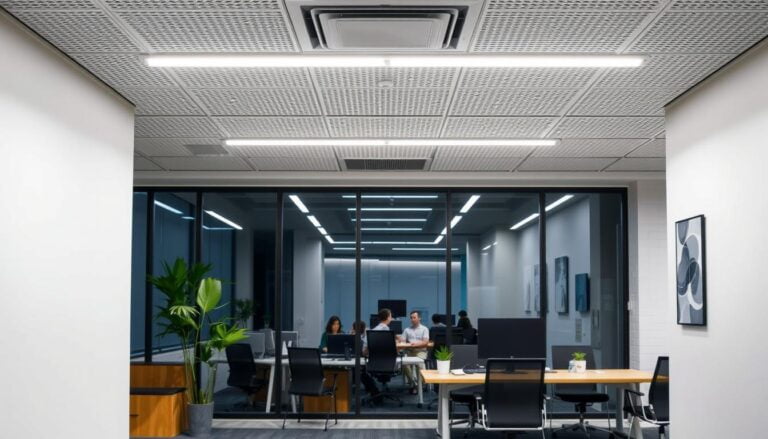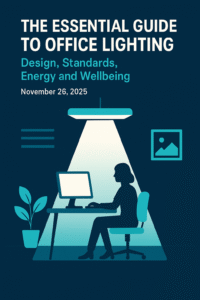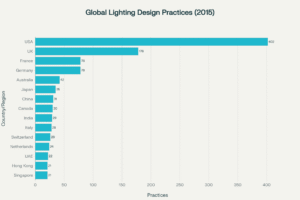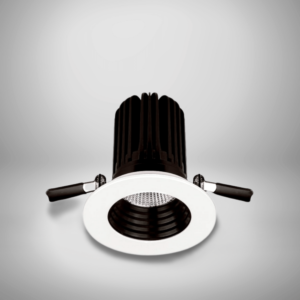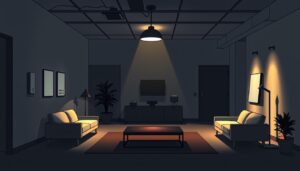LED lighting and smart features are becoming more popular in commercial areas. They change how we light up our workspaces. Now, we get both energy saving and reporting data that allows us to take actions based on the facts and figures.
Smart lighting does more than just light up a space. It uses advanced sensors to detect movement and natural light. This means lights turn on and off automatically, saving energy and cutting costs.
By using these smart lighting technologies, businesses can control their lighting better. This leads to a more productive, comfortable, and green work environment. It’s good for both the business and its employees.
Introduction to Smart Lighting for Commercial Properties
Commercial lighting has changed a lot in recent years. We’ve moved from old lighting to smart lighting technology. This change is making businesses more efficient.
The evolution of commercial lighting systems
Commercial lighting has evolved from simple incandescent bulbs. Now, LED solutions offer big benefits:
- 75% less energy used
- Lasts 25 times longer than old bulbs
- Can last over 3 years if on 24/7
Defining smart lighting solutions
Smart lighting is more than just energy-saving bulbs. It connects with the Internet of Things (IoT). This lets us control and customise lighting like never before:
- Controlled wirelessly with Bluetooth and Wi-Fi
- Managed through the cloud, no hub needed
- Adjust brightness, colour, and intensity for each light
The Impact on business operations
Smart lighting is changing commercial spaces and making businesses more efficient:
| Benefit | Impact |
|---|---|
| Energy Savings | Up to 66% less lighting energy use |
| Cost Reduction | 20-50% less electricity costs |
| Productivity | Better focus and support for the body’s natural rhythm |
| Maintenance | Check and test lighting in real-time |
With these benefits, it’s clear smart lighting technology is key for the future of commercial properties and businesses.
Energy Efficiency: A Cornerstone of Smart Lighting
Smart lighting systems are changing how businesses use energy. Since the UK banned halogen bulbs in September 2021, companies are now using energy-efficient lighting. These solutions bring big benefits.
Sensor-based lighting adjustments
Sensor-based office lighting is key to saving energy. These systems adjust light based on who’s there and the natural light available. This means less energy is used when no one is around. Businesses can save up to 30% on their electricity bills.
Daylight harvesting techniques
Daylight harvesting is important for saving energy. It adjusts artificial light based on the natural light available. This can cut electricity use for lighting by up to 70%.
Reducing carbon footprint through smart lighting
Smart lighting helps reduce carbon emissions. LED lights last a long time and use much less energy than old bulbs. This means less energy is used, which is better for the planet.
| Lighting Type | Energy Savings | Lifespan (hours) | Carbon Footprint Reduction |
|---|---|---|---|
| LED | Up to 80% | 25,000 – 50,000 | Significant |
| CFL | Up to 75% | 8,000 – 10,000 | Moderate |
| Halogen | Up to 30% | 2,000 – 4,000 | Minimal |
By using smart lighting, businesses can cut their energy use, lower costs, and help the planet. The long-term benefits of energy-efficient lighting are clear. It’s a smart choice for businesses looking to the future.
Cost Savings: The Financial Benefits of Smart Lighting Solutions
Smart lighting solutions bring big financial benefits to commercial properties. They offer great energy savings and cut down on maintenance costs. This makes them a smart choice for businesses wanting to improve their operations.
LEDs are an integral part of smart lighting. They use up to 75% less energy than old incandescent bulbs. This big drop in energy use means lower electricity bills. For example, a retail store saw a 40% cut in energy costs the first year after switching to smart lighting.
LED luminairesalso last much longer, which means less money spent on replacements. They can last up to 25 times longer than bulbs. This is especially good for places that are hard to get to or have high ceilings, where changing bulbs is a big job.
| Aspect | Traditional Lighting | Smart Lighting |
|---|---|---|
| Energy Consumption | High | Up to 75% less |
| Bulb Lifespan | Short | Up to 25 times longer |
| Maintenance Frequency | High | Low |
| Energy Cost Savings | None | Up to 40% in the first year |
Smart lighting systems also offer useful data insights. Businesses can see how much energy they use in real-time. This helps them find ways to save more money and use resources better. Even though smart lighting costs a bit more at first, the savings on energy and maintenance over time make it a wise choice for businesses.
Smart Lighting Solutions for Businesses: Features and Capabilities
Smart lighting solutions are changing how businesses work in the UK. They bring new features that make things more efficient, productive, and comfortable in offices and shops.
Internet of Things (IoT) Integration
IoT lighting connects with other smart devices and systems. This makes a space work better together. Lights can change based on how many people are there and how much natural light there is. Using IoT tech, businesses can save energy and adjust lighting for different situations.
Remote Control and Monitoring
Smart lighting lets you control it from anywhere with apps or voice commands. This means you can easily manage lights in different places. It helps keep the lighting right at all times.
Data Analytics for Informed Decision-Making
Lighting data analytics give insights into how often spaces are used, energy use, and what people like. This helps businesses make smart choices about how to use resources and space. It leads to better efficiency and saving money.
| Feature | Benefit |
|---|---|
| IoT Integration | Cohesive environment, optimised energy use |
| Remote Control | Flexibility, ease of management |
| Data Analytics | Informed decision-making, improved efficiency |
By using these smart lighting features, businesses can make their spaces better. IoT, remote control, and data analytics work together for a full solution for today’s lighting needs.
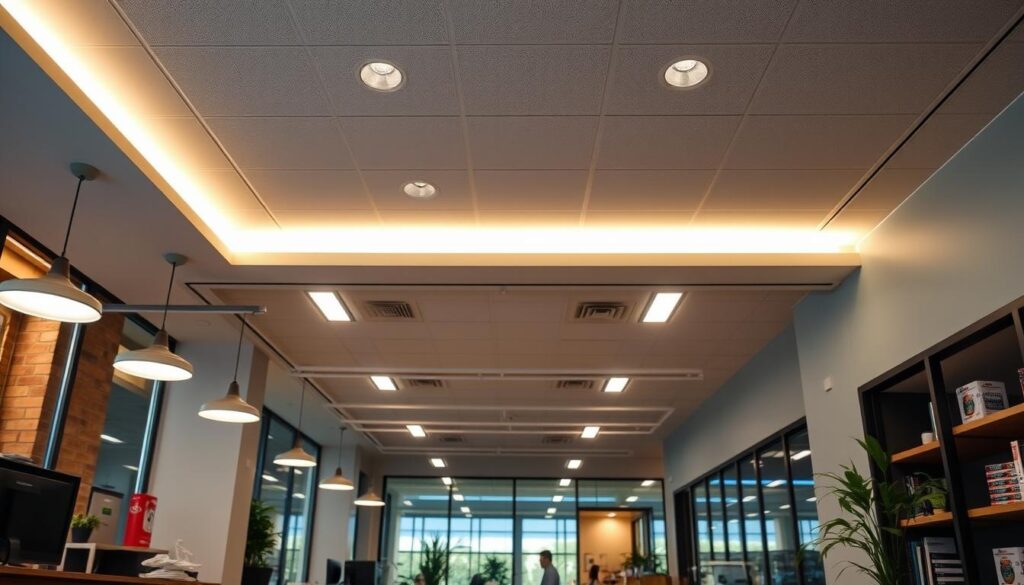
Enhancing Productivity and Well-being in Commercial Spaces
Smart lighting solutions are changing the game in commercial spaces. They offer unmatched control over the work environment. These systems do more than just light up the space. They play a key role in boosting employee productivity and improving workplace well-being.
Circadian Rhythm Lighting and Its Effects
Circadian lighting mimics natural light patterns during the day, helping our body clocks. This approach can better sleep quality, lift moods, and make us more alert. Without enough sunlight, people might lose up to 46 minutes of sleep each night. This shows how vital proper lighting is in the workplace.
Customisable Lighting Scenes for Different Tasks
Smart lighting systems let you set the right lighting for different tasks. Warm lighting is great for creativity and chilling out, while cooler tones help with focus and productivity. This flexibility lets businesses tailor their lighting to fit various tasks and what employees like.
Improving Employee Comfort and Satisfaction
Good lighting makes employees more comfortable and happy. It cuts down on eye strain, headaches, and feeling tired. Being able to adjust the lighting makes employees feel more in control, leading to better job satisfaction and possibly more people staying with the company.
| Lighting Type | Effect on Productivity | Impact on Well-being |
|---|---|---|
| Warm Lighting | Enhances creativity | Promotes relaxation |
| Cool Lighting | Improves focus | Increases alertness |
| Circadian Lighting | Boosts overall productivity | Supports natural sleep-wake cycle |
By choosing smart lighting, businesses can make their workspaces more productive, comfy, and satisfying. The perks go beyond saving energy. They directly help employees do better and feel better, making it a smart move for any modern business.
Creative Smart Lighting Solutions for Modern Interiors
Smart interior lighting has changed how we light up commercial areas. Now, we can make offices and shops change to fit different needs and moods. This is thanks to new lighting designs.
Modern office lighting has many features beyond just lighting up a space. With colour-changing LEDs, businesses can make their spaces match their brand. They can quickly switch between lighting scenes for meetings, presentations, or events.
Smart lighting fits well with the look of a building, making certain features stand out. In modern offices, these lights help create different areas. They make spaces for working together better and welcome areas more inviting.
“Smart lighting is not just about energy efficiency; it’s about creating environments that inspire and adapt,” says Sarah Johnson, interior design expert.
Smart lighting can change with new design trends and business needs. It has features like motion sensors and remote control. These make it easy to use and save energy.
| Feature | Benefit |
|---|---|
| Colour-changing LEDs | Create brand-aligned environments |
| Programmable scenes | Adapt to different activities |
| Motion sensors | Improve energy efficiency |
| Remote control | Convenient management |
By using these smart lighting solutions, businesses can make their spaces more engaging and efficient. They can adapt to the changing needs of modern work.
Integrating IoT in Office Lighting: The Future of Workspace Management
IoT office lighting is changing how we manage workspaces. Smart sensors and occupancy detection systems are making lighting control smarter. They boost energy efficiency, comfort, and productivity for employees.
Sensors and Occupancy Detection
IoT-enabled lighting uses advanced sensors to track movement and occupancy. This means lights can turn on and off based on who’s there. For example, lights in meeting rooms turn off when no one is there, saving energy and money.
Smart Lighting as Part of Building Automation
Smart building automation links lighting with systems like HVAC and security. This approach optimises resource use and makes the work environment more comfortable. For instance, smart devices help find meeting rooms or colleagues, improving teamwork and productivity.
Scalability and Future-proofing Your Lighting Infrastructure
Choosing future-proof lighting means your setup can grow with technology. IoT-enabled lighting is scalable, letting businesses expand or change their lighting as needed. This flexibility helps companies stay ahead with new smart building tech.
| Benefits of IoT Office Lighting | Impact |
|---|---|
| Energy Efficiency | Up to 30% reduction in energy consumption |
| Cost Savings | Significant decrease in operational expenses |
| Employee Productivity | Improved workspace utilisation and comfort |
| Maintenance | Proactive issue detection and resolution |
By using IoT office lighting and smart building automation, businesses can make workspaces more efficient, comfortable, and productive. These solutions offer immediate benefits and set the stage for ongoing innovation in managing workspaces.
Tunable White Light for Productivity: Adapting to Natural Rhythms
Tunable white light is changing how we work in the UK. It lets us change the light’s colour temperature during the day, like the sun’s light. This helps our bodies stay in sync with nature.
Research shows that natural light can cut down on sick days by up to 4 days a year for each worker. This means big savings for companies. Tunable white lighting has a wide range of colours, great colour quality, and low glare.
This light isn’t just for offices. Schools see students paying more attention and sleeping better. Hospitals see less aggressive behaviour in dementia patients. Shops might sell more because of the right lighting. Tunable white lighting can save up to 25% on energy costs and another 30% with daylight sensors.
Now, tunable white LED systems are more affordable. They’re easy to use, thanks to apps instead of complicated wiring. This makes them a must-have for any business wanting to boost productivity and make employees happier.
FAQ
What are the key benefits of smart lighting solutions for commercial spaces?
Smart lighting solutions bring many advantages to commercial properties. They make energy use more efficient, cut costs, boost productivity, and let you create lighting that suits different tasks and tastes.
How do smart lighting systems contribute to energy efficiency?
Smart lighting uses sensors to turn lights on and off automatically. They adjust based on motion and natural light. This helps save energy. Daylight harvesting also plays a part by using less artificial light when natural light is enough.
What financial benefits do smart lighting solutions provide?
Smart lighting cuts energy use, making bills lower. LED bulbs last longer and need less upkeep, saving money. The cost of installing smart lighting can be paid back by saving on energy and maintenance.
What advanced features do smart lighting systems offer?
Smart lighting systems are connected to the internet, controlled remotely, and can be monitored. They also provide data on how people use spaces, energy use, and what lighting people prefer.
How can smart lighting enhance productivity and well-being in the workplace?
Smart lighting that follows natural light patterns can help the body’s internal clock. This might make people feel better, focus better, and work better. Custom lighting can also make different tasks easier, making the workplace better for everyone.
What are some creative applications of smart lighting for modern interiors?
Smart lighting can change colours and patterns, making spaces look dynamic. It can be set to match different moods or highlight certain areas. This makes modern offices more interesting and functional.
How does IoT integration benefit office lighting systems?
IoT in office lighting means lights can be controlled based on how they’re used. It works well with other building systems and can grow with new tech and business needs.
What is tunable white light technology, and how can it benefit productivity?
Tunable white light lets you change the colour of light during the day, like natural light. This helps keep your body clock in check, makes you more alert, and helps you think better. This could make people more productive at work.
